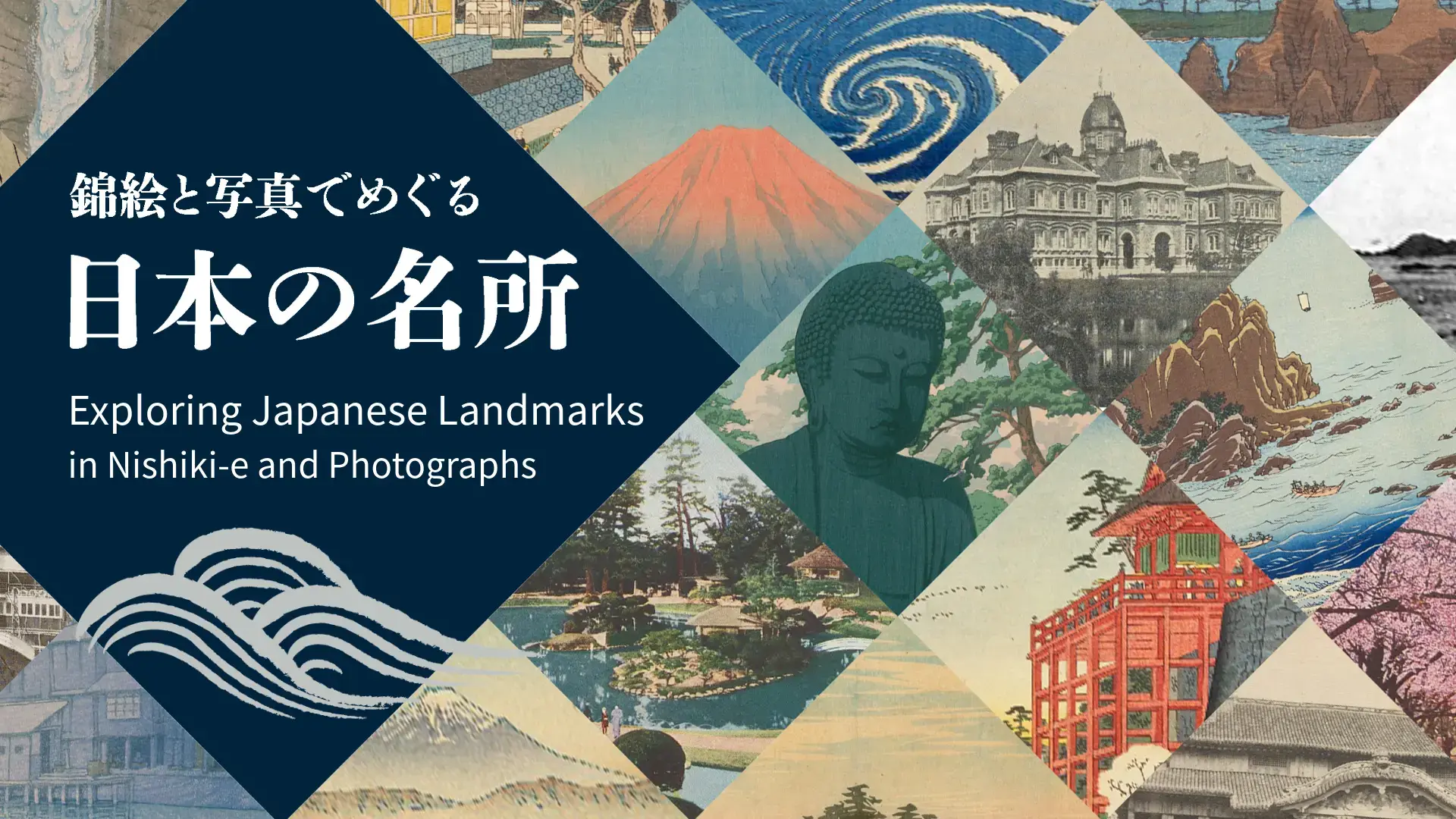
御霊文楽座
このコラムは、平成20年に電子展示会「写真の中の明治・大正(大阪編)」の中で公開したコラムを移行したものです。内容は当時の記載内容に基づきます。
写真は、明治17(1884)年から大正15(1926)年の間、御霊(ごりょう)神社(現在の住所では大阪市中央区淡路町5丁目)内にあった「御霊文楽座」における公演の模様である。人形浄瑠璃の世界に浸る観客の後ろ姿には静かな印象があるが、御霊文楽座はただ観劇する場というだけでなく、大店の旦那衆の社交、商談の場としても利用されていた。
御霊文楽座の表には絵看板、木戸をくぐれば右手には勘定場、左手には茶屋の入り口がある。客席は1階と2階にあり、1階の平土間は枡にくぎられた席、その両側に桟敷席があって、750人程度の観客を収容できる。大型のランプ7基によって、間口が約13mある舞台を照らす。茶屋では「注文すると冬は炬燵を桟敷まで運んでくれたし、燗酒を飲みながらの観劇は、当時としてはおつな遊び」(『人形浄瑠璃の歴史』)であったそうである。
「文楽」の成り立ち
文楽というと、今日では人形浄瑠璃そのものの呼称として一般的に使われることが多いが、もともとは植村(正井)文楽軒という人物が興行をした人形浄瑠璃、またはその人形浄瑠璃を上演する劇場の名前であった。「植村文楽軒」とは雅号である。初代文楽軒は淡路の出身で、大坂に出て浄瑠璃の稽古所を開いたのが「文楽」の始まりと言われている。その年については諸説あるが、19世紀の初めころ、11代将軍徳川家斉の時代であった。
文化8(1811)年、二世文楽軒は場所を大坂博労町(ばくろうまち)の難波神社の境内で興行をはじめる。これは通称「稲荷の芝居」と呼ばれる。もともと寺社境内での芸能興行は、宮芝居または宮地芝居と呼ばれて以前から定着していた。その理由のひとつとして、明治以前の芝居は名代(1)の免許によって興行を認める制度のもとで行われていたのだが、寺社境内での興行は寺社の繁栄に寄与することを目的に、名代の免許がなくとも興行ができたことがあげられる。
天保13(1842)年5月には、老中水野忠邦の天保の改革による宮芝居禁止令のために一座は移転を余儀なくされたが、安政3(1856)年9月には再び難波神社に戻ってくることが叶う。この頃の座元は、歴代文楽軒の中でも特に興行師としての手腕をもつ人物と伝えられる文楽翁(2)である。
明治に入ると、大阪市は当時まだ交通が不便であった松島に花街や劇場を誘致し、その活性化を目指す策をとった。文楽翁はこの流れをみて一座を松島に移し、明治5(1872)年1月に「官許人形浄瑠璃文楽座」の看板をあげ、宣伝につとめる。文楽座という名称が正式に使われたのはこのときが最初である。松島の文楽座は、客足の減少、幹部座員の退座騒動といった経験を重ねながらも、その人気を固めていった。
17(1884)年、文楽翁と対立した一部の幹部座員が一座を脱退し、非文楽系の人々を集め、かつて文楽軒の小屋のあった難波神社境内で彦六座の旗上げをする。一方で彦六座の躍進に負けじと文楽翁は、松島よりも地の利のある御霊神社境内にあった土田席を買収し、小屋を新築して「御霊文楽座」を開場する。南北1km程度しか離れていない御霊文楽座と彦六座の競合は、人形浄瑠璃界を二分する激しいもので、これにより技芸は向上し、幾多の名人が輩出した。この時期が明治の人形浄瑠璃の黄金時代と言われる。
文楽座の変遷
彦六座は、明治26(1893)年の秋に廃座となる。客席に畳を敷くといった設備改善、人形浄瑠璃の新作改作などの試みを積極的に行ったが、21(1888)年の火災、看板役者の死去、幹部座員の退座などの不運が重なった結果であった。27(1894)年に名称を稲荷座と改めて再建されるが、31(1898)年には三味線の名人豊沢団平の急死をきっかけに解散、その後も小屋を変えながら大正時代まで文楽座に対抗したが、ついにはその拠点を失う。
一方で御霊文楽座は、興行日数が延び、観客の入りもよい時期を迎える。36(1903)年の二代目竹本越路太夫の「摂津大掾」号受領(3)に伴う披露興行では連日大入り満員を出した。竹本摂津大掾の生涯と文楽座での興行の様子に関しては、水谷不倒の『竹本摂津大掾』に詳しい。なお竹本摂津大掾は、自身の著書『義太夫の心得』において、芝居小屋の構造にフランスの建築方式なども考慮した議論がなされたり、ガスや電気が小屋に取り入れられたりする流れを「斯様なことは先づ芝居道に於きましても非常な進歩と申して宜しい」と前向きにとらえている。そのうえで御霊文楽座に対しては「西洋風の学理上から割出した構造を応用しまして、今少し音声が能く隅々へ迄も行渡るやうに致したいものだ」と問題提起している。
しかし、この近代化の流れから生まれた新しい芝居や映画などの大衆娯楽が、御霊文楽座の経営を次第に圧迫する要因のひとつとなる。そして42(1909)年3月、御霊文楽座の経営は、当時の新興興行資本であった松竹合名社(のちの松竹株式会社)の手に渡る。松竹は設備の改良や興行時間の変更などの改革を実施し、いったんは観客を劇場に呼び戻したが、大正期の後半にはまた不入りが続き、苦しい経営を迫られる。
大正15(1926)年11月、御霊文楽座が人形の首や衣装とともに焼失した事件は、経営不振に追い討ちをかけるものであった。しかし逆風の中でも文楽の興行は粘り強く続けられ、昭和5(1930)年1月、西区四ツ橋に新装成った文楽座が開場した。四ツ橋文楽座は20(1945)年3月、空襲で焼失するが、終戦を迎えるといちはやく再興され、21(1946)年2月には復興記念興行が行われた。
24(1949)年、文楽は待遇改善を巡って因会と三和会に分裂する。松竹傘下の因会は31(1956)年、四ツ橋から道頓堀(のち「朝日座」と改称)に拠点を移し、三和会は地方巡業などにより公演を続けた。
今日の文楽
昭和38(1963)年4月、両者が合同し財団法人文楽協会が発足、文楽は松竹株式会社の経営の手を離れ、国や大阪府、大阪市、NHK、関西の財界の支援を受けて運営されることとなる。59(1984)年4月には大阪日本橋に国立文楽劇場が開場し、朝日座に代わる文楽の主会場となった。
平成15年(2003)11月7日、人形浄瑠璃文楽はユネスコから「第2回人類の口承及び無形遺産の傑作の宣言」において優れた無形遺産に選ばれた。文楽に時代や場所、文化背景の違いを越えた魅力があるという証左であろう。
大阪の庶民に親しまれ発展してきた文楽は、こうしていまに引き継がれている。
注
引用・参考文献
- 廣瀬久也『人形浄瑠璃の歴史』戎光祥出版,2002 【KD475-G67】
- 祐田善雄『浄瑠璃史論考』中央公論社,1975 【KD475-14】
- 国立文楽劇場管理課編『文楽鑑賞モノグラフ』(古典芸能入門シリーズ;1)国立文楽劇場,1985 【KD475-41】
- 鳥越文蔵[ほか]編『今日の文楽』(岩波講座歌舞伎・文楽;第10巻)岩波書店,1997 【KD475-G13】
- 権藤芳一『文楽の世界』講談社,1985 【KD475-38】
- 山田庄一『文楽入門』(文研の芸能鑑賞シリーズ)文研出版,1977 【KD475-17】
- 藤田洋編『文楽ハンドブック』三省堂,2003 【KD2-H9】
- 三善貞司編『大阪史蹟辞典』清文堂出版,1986 【GB8-155】
- 大岡欽治・中瀬寿一編『近代大阪の史跡探訪』(ナンバーガイド;34)ナンバー出版,1975 【GC163-12】
- 日外アソシエーツ株式会社編『20世紀日本人名事典.そ‐わ』日外アソシエーツ,2004 【GB12-H35】
- 松平盟子『文楽にアクセス』(劇場に行こう)淡交社,2003 【KD475-H13】
- 水谷不倒『竹本摂津大掾:二代目越路太夫』博文館,1904 【768.42-Ta519Mt】
- 竹本摂津大掾述『義太夫の心得』中島辰文館[ほか],明治44(1911) 【94-751】
- 芳賀登[ほか]編『日本人物情報大系.第83巻 諸芸・諸職編.3』皓星社,2001 【GB12-G22】



